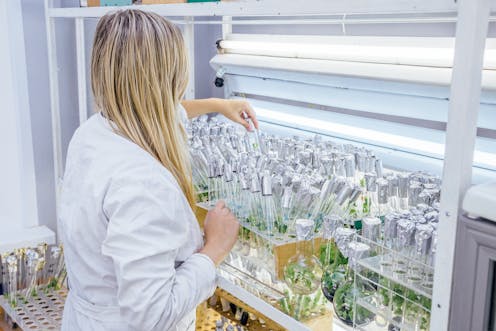Fearmongering is scary, not genetic technologies themselves
- Written by Isobel Ronai, University of Sydney

Australia’s gene technology regulations have not been revised since 2001 - despite many game-changing advances in genetic technologies over the past 17 years.
A review of the regulations by the Office of the Gene Technology Regulator (a Federal government body) involved a public call for submissions and has also triggered some fears about what changes are to come. Will it mean genetically modified organisms (GMOs) – plants, animals or even humans – will not be regulated?
We argue that the proposed changes to the regulations will actually involve more oversight of genetic techniques, including the poster-child of new approaches: CRISPR.
Read more: What is CRISPR gene editing, and how does it work?
CRISPR (or more precisely, CRISPR-Cas) is a molecular technology that has been developed from a naturally occurring mechanism in bacteria, and is used to alter DNA.
Prior to the proposed amendments by the Office of the Gene Technology Regulator, the regulation of CRISPR-Cas was a bit ambiguous. Rather than opening the door for genetic editing to become more widespread, the proposed changes more tightly regulate the use of CRISPR-Cas technology.
How CRISPR works
The CRISPR-Cas technique is prized by researchers because it is an efficient and precise way to alter DNA (as well as other molecules such as RNA).
There are two main applications of CRISPR-Cas: to increase genetic variation (that is, slight changes in the DNA sequence), and to edit the DNA (an approach similar to “cutting and pasting”, where known bits of DNA are taken out and alternatives added back in).
Traditionally, genetic variation arose naturally and individuals with desirable traits were selectively bred by humans. We have been doing this for thousands of years, and selective breeding is responsible for a lot of the food that we eat today. About a century ago, X-rays and chemicals started to be used to increase the amount of genetic variation of organisms (typically plants) which can be selectively bred. This has generated more than 3,000 horticultural plant varieties that we consume today, none of which are classified as GMOs.
CRISPR-Cas can be used in a similar way to X-ray and chemical methods, but with an advantage: it can target specific sequences of the DNA, minimising unwanted, bystander effects in other parts of the DNA. In the proposed regulation changes, CRISPR-Cas-induced variations of this kind would be classified in the same way as other technologies achieving the same outcome – they are not GMOs.
Read more: Perceptions of genetically modified food are informed by more than just science
As well as inducing variation, CRISPR-Cas is best known as an “editor” which can cut and paste particular bits of DNA. When DNA is added to an organism, they are classified as GMOs, and would still be according to the proposed regulation changes.
When CRISPR-Cas technology is used for editing, it can also be used to create changes in the DNA of an organism that will then spread in subsequent generations - this is referred to as a “gene drive”. But CRISPR-Cas is not the only way to achieve this, and the proposed changes increase the regulations for the use of all kinds of gene drives.
Fearmongering
Columnist Elizabeth Farrelly recently argued that proposed updates to Gene Technology Regulations entail the “deregulation” and “declassification” of CRISPR-Cas such that it would “no longer count as genetic modification” in Australia. This is not the case.
The column also appears to argue that changes to the legislation mean that designer babies are both technically possible and imminent.
But in Australia, both the current (2001) and proposed changes to the regulations by the Office of the Gene Technology Regulator do not cover the use of CRISPR-Cas technology in humans - only other organisms that are not destined for human food. Further, the 2015 “International Summit on Human Gene Editing” put a moratorium on gene editing in viable human embryos.
Worries about designer babies stemming from the current and proposed genetic technology regulations are not substantiated.
Read more: Human embryo CRISPR advances science but let's focus on ethics, not world firsts
Focus on outcomes, not process
The lesson here is not that we should blindly trust scientists and regulators when it comes to new technology. We agree that emerging technologies can pose risks.
Rather, the take-home message is that technological regulation needs to focus on outcomes of the technology, not the technology itself.
Let’s consider another technology: 3D printing.
Advances in 3D printing means that the opportunities for creating new products are endless. You can print a house, a car, a prosthetic limb - and also a weapon. Does this make 3D printing something to be afraid of?
We think not. 3D printing can have many uses, malevolent or life-transforming. Scaremongering about 3D printing technology, rather than considering the uses of the technology, is a misguided approach to regulation.
A 3D-printed cast should be regulated differently to a 3D-printed gun. And this kind of regulation is exactly what the proposed updates to the Gene Technology Regulations hopes to achieve.
What the updates do address is a change from a process based assessment of technology to an outcome based one. In the same way that we might not want 3D printing banned in Australia, some regulation on the various outcomes arising from new genetic technologies are necessary.
Authors: Isobel Ronai, University of Sydney
Read more http://theconversation.com/fearmongering-is-scary-not-genetic-technologies-themselves-92171



